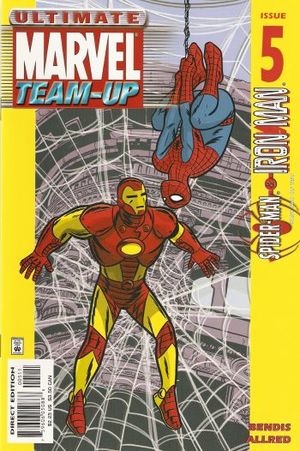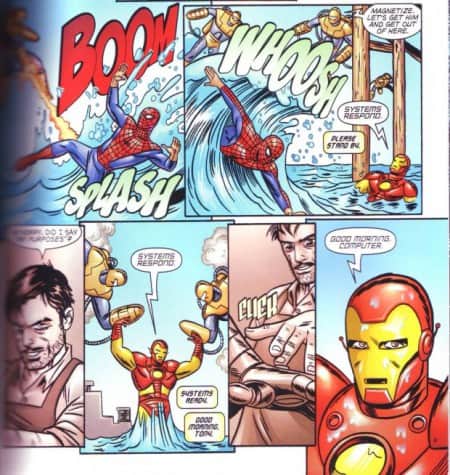
Written by Brian Michael Bendis
Art by Mike Allred
Colors by JC
Published by Marvel Comics
Ultimate Marvel Team-Up #4 is the first appearance of Iron Man in the Ultimate Universe. Unlike the last arc featuring Hulk, writer Brian Michael Bendis and artist Mike Allred actually go into his origin and backstory updating it for the early 2000s in a way that’s a little retro, a little charming, and still retains many elements of the original Stan Lee, Larry Lieber, Don Heck, and Jack Kirby creation. (That’s a lot of cooks in the kitchen.) But all this focus on Iron Man’s origin leaves little room for his team-up with Spider-Man against some generic Transformers resembling Latverian mercenaries. The plot of this story involves the Latverians having a kind of technology to take down the Iron Man armor, which Iron Man is flailing around like a big red and yellow dumbass for most of the issue. This might work if say, their unnamed dictator, who may or may not be Dr. Doom, had created a stasis field to neutralize his armor, but this is never revealed not even in a two page stinger featuring Nick Fury. Luckily, Tony Stark and Peter Parker’s shining personalities along with Mike Allred keep things decently entertaining even if the villain and plot aren’t up to snuff.
In 2001, Iron Man was obviously not the pop culture icon he is today, except to Wu Tang Clan member Ghostface Killah. He had his own underwhelming cartoon in the mid-1990s as part of the Marvel Action Hour, but it paled in comparison to the X-Men, Spider-Man, and Incredible Hulk show, which gained immortality as the pre-ride video for the Hulk roller coaster at Universal Studios Florida. He also showed up in the Marvel Superheroes and Marvel vs. Capcom fighting games. In Ultimate Marvel Team-Up #4-5, Bendis and indie darling (Madman) and then penciller on the satirical X-Force series Mike Allred strive to make him part of mainstream pop culture and not a second stringer through visuals and by giving him an engaging and redemptive backstory.
First, of all, even before he and Bendis reveal that there is an in-universe Iron Man film starring Tom Cruise, Mike Allred makes Tony Stark a dead ringer for for classic movie star Clark Gable. Allred indulges in the 1960s Cold War vibe that the character has only recently escaped by using the originally Kirby designed armor and having him escape from a Central American terrorist group called the Red Devils. A single page spread of an audience of fans marveling at an Iron Man suit lifting a one ton weight is a small glimpse into a simpler time of heroes that immediately goes to hell when the rest of the plot is Iron Man and Spider-Man dealing with his sabotaged suit. JC also leaves his usual turn of the millennium digital color palette for some bright Silver Age fun, especially in the red and yellow of Iron Man’s suit and blue and yellow of the Latverians’ armor. (Spider-Man’s red and blue is in the middle of the spectrum.)
But despite its Kirby krackles, grid-style storytelling, and acrobatic energy in the fight scenes (except when Tony Stark is just falling), Bendis and Allred build a new, more responsible model of Tony Stark like the one seen in the Iron Man films. Yes, he spends the entire meeting with the Latverian ambassador making jokes about bowling with the President and shows off his womanizer side by agreeing to go to a UN Expo because there will be beautiful women there. However, he is passionate about making sure his clumsily named Irontech doesn’t fall into the hands of the military industrial complex. This kind of responsibility is what draws Peter Parker to make a rousing speech about him to get a chance to meet him at the expo and see him as a role model. There is a strong thematic connection through science and responsibility between Stark and Parker at the beginning of Ultimate Marvel Team-Up #4, but it turns into robot fights and malfunctions even if Spider-Man sciences the hell out of the Latverian mercs to take them out.
Stark’s dark past as anti-Communist propaganda figure and an in-universe arms dealer in explored in the mostly sepia toned Ultimate Marvel Team-Up #5, which tries to tell an origin story and superhero team-up story. It nails the Iron Man origin story, but the main story is just Iron Man being incompetent and Spider-Man joking while the Latverians take forever to extract their operatives. It’s really boring stuff until Allred lets Iron Man cut loose in a double page spread spanning both his past and present with the crackling energy of repulsor rays. Here is a man, who became a hero when he found out that he had a brain tumor, and this gave him the clarity and drive to create marvels. Tony Stark is still a cocky billionaire, but he won’t support dictatorships even if they offer him a fat paycheck.
Ultimate Marvel Team-Up #4-5 is a decent, if a little rushed retelling of Iron Man’s origin story awkwardly sandwiched into a mandated team-up with Spider-Man because this is technically his book. There are some nice contrasts and similarities between them like their shared passion for science, and the fact that Stark has a private jet while Peter Parker saves money by web-swinging between places instead of taking the subway. Brian Michael Bendis is a nice fit for Tony Stark’s glib, yet intelligent dialogue, and Mike Allred has a ball drawing his strong jawline as he makes the Latverian visibly sweat at their meeting. And the fight between him and the mercs gives him a chance to indulge his Kirby-esque sensibilities with energy discharging and robots flying everywhere. If anything, Ultimate Marvel Team-Up is a place to see the best storytellers in comics introduce new fans to legendary characters.



